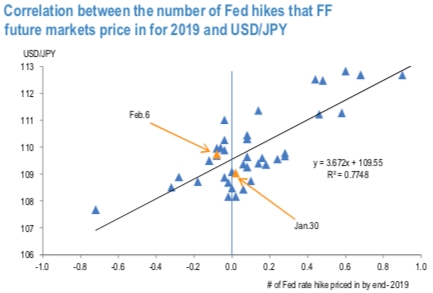JPY has been a middle-ranked but relatively weak currency within the G10 camp. Meanwhile, developments in the recent past:
1) An unexpected dovish turn by the Fed at the January FOMC resulting in a bearish view on USD,
2) The heightened concerns over the outlook of the global economy in favor of a bullish JPY view, and
3) The growing speculation that there will be upward pressure on JPY due to repatriations towards end-FY2018 (March 2019).
These factors, however, have likely supported the JPY bottom.
After a short-lived flash crash spike at the turn of the year, Yen vols have resumed their downtrend and are well on their way to testing their lows from 2Q’14 (refer 4th chart). The break of 8.0 on USDJPY 1Y ATM vol back in December had caused a frisson of excitement among vol accounts looking to buy Yen vega as a strategic late cycle FX vol play, but what was deemed to be a key technical support level has long since been left in the dust. 7.0 now looms as the next major target, beyond which there is still substantial room to fall to revisit pre-GFC levels in the 6s.
It is difficult to argue with option prices steadily softening when the spot is stuck in a tight 109-111 range and delivering 2-2.5 pts. below implieds.
There is also a case to be made that the ongoing softness in realized vols can continue longer than some anticipate, since the propensity of the Yen to rally in market downturns is being dampened by a cyclically wide US-Japan interest rate differential that is fuelling above-average equity and FDI outflows, alongside a reduction in FX hedge ratios of traditionally well-hedged foreign bond purchases.
The number of Fed hikes that the FF future markets are pricing in for 2019 has continued to have a relatively strong correlation with USDJPY (refer 1stchart). FF future markets did not price in any hike even before the FOMC on January 30th.
The BoJ introduced a negative interest rate policy in end-January but this was
not sufficient to counter the deterioration in global risk sentiment. Also, it is worth noting that these developments led to the revision of the policy rate forecast at the March FOMC in 2016. Separately, Japanese investors net-sold foreign stocks and investments funds in April after entering into the new FY, following the global stock sell-off (refer 2nd chart). Meanwhile, Japanese investors remained net buyers of foreign bonds in this period— likely accompanied by JPY selling (refer 3rd chart). In 2018, JPY appreciated amid a rapid rise in VIX and global stock sell-offs in February and March. Japanese investment trusts also net-sold foreign stocks and investments funds in February and March, which might have contributed to the acceleration in JPY appreciation. Courtesy: JPM
Currency Strength Index: FxWirePro's hourly USD spot index was at 49 (which is bullish), while hourly JPY spot index was at 29 (bullish) at 07:18 GMT.
For more details on FxWirePro's Currency Strength Index, visit http://www.fxwirepro.com/currencyindex



 Why central banks should stop raising interest rates
Why central banks should stop raising interest rates  FxWirePro- Gold Daily Outlook
FxWirePro- Gold Daily Outlook  RBA's latest forecasts are grim. Here are 5 reasons why
RBA's latest forecasts are grim. Here are 5 reasons why  Governments have been able to overrule the Reserve Bank for 80 years. Why stop now?
Governments have been able to overrule the Reserve Bank for 80 years. Why stop now?  Why the Bank of England is now more upbeat than the IMF
Why the Bank of England is now more upbeat than the IMF  Core- Bitcoin Layer 1 Blockchain with Satoshi plus novel consensus mechanism
Core- Bitcoin Layer 1 Blockchain with Satoshi plus novel consensus mechanism  Will the RBA raise rates again? Unless prices surge over summer, it's looking less likely
Will the RBA raise rates again? Unless prices surge over summer, it's looking less likely  Nervos network- Multi-layered blockchain
Nervos network- Multi-layered blockchain  If central banks don't start cutting them soon, it could actually increase inflation
If central banks don't start cutting them soon, it could actually increase inflation  Inflation: raising interest rates was never the right medicine
Inflation: raising interest rates was never the right medicine  The RBA has kept interest rates on hold. Here's why it'll be cautious from here on
The RBA has kept interest rates on hold. Here's why it'll be cautious from here on 





























